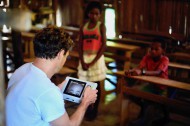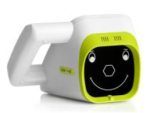Système Medoc TSA II
TSA-II - NeuroSensory Analyzer for Sensory Testing
An essential Quantitative Sensory Testing (QST) tool for evaluating nerve impairment and sensory testing in clinical, research and pharmacological trial settings
The TSA-II NeuroSensory Analyzer is a precise, computer-controlled device capable of generating and documenting response to highly repeatable thermal and vibratory
stimuli, such as warmth, cold, heat-induced pain, cold-induced pain orvibration. The TSA-II
sensory testing covers small-fiber testing (A-Delta and C-fiber), as well as for large caliber (A-Beta fibers) testing. The TSA-II is also used for identifying thermal pain thresholds in various
clinical and research applications.
TSA thermal stimulator test procedure
The test procedure itself is similar to that employed in such routine tests as eye and hearing examinations, where patients are asked to respond to visual or auditory stimuli. Sensory testing is performed by applying the TSA-II thermode on the patient's skin to heat or cool the skin. Patients respond to the temperature stimuli by pushing a button, and the sensory threshold is recorded and automatically compared to an age-matched normative data.
A deviation from the normal range can indicate the existence of peripheral nerve disease or damage due to injury, illness or toxic exposure. Testing comparing contra-lateral body sites and longitudinal (or serial) evaluation before and after therapy can also be routinely employed.
Test result reports are generated in a variety of graphical formats.
Dr. Martin Angst from the department of anesthesia at Stanford University is using the TSA II for determining heat and mechanical pain threshold as described
here.
 |
|
|
TSA-II NeuroSensory Analyzer Test |
TSA-II Features
- Outcome-based color graphic reports with automated narrative discussion of test results for insurance and referral networks
- Automatic comparison of test results to normative reference data
- Portable, fast set-up and ease of use
- Versatile WINDOWST based software with selection of test paradigms for maximum flexibility in clinical, research and drug trial applications.
- Various test methods (Limits, Levels and Manual)
- Factory installed default protocols for immediate clinical use
- Proven Repeatability
Useful in monitoring, treating and testing in:
- Fibromyalgia
- Painful neuropathies
- Lumbar Radiculopathy
- Small-fiber allodynia in Complex Regional Pain Syndrome (CRPS)
- Underlying Central Nervous System impairment in difficult-to-diagnose patients
- Early detection of diabetic neuropathy of small-caliber nerve fibers
- Effectiveness of growth factors, aldosereductase
- Inhibitors and other new therapies
- Entrapment and toxic neuropathies
- Testing programs to detect malingerers
- Nerve root compression and inflammation
Tags : QST, test thermique, thermotest, quantification objective de la douleur, Evaluation sensorielle par thermotest, sensibilité cutanée thermique, petites fibres nerveuses a delta et c, sensation de douleur, neuropathic pain qst, nociceptive pathway function, réponse objective, quantitative sensory testing, douleurs neuropathiques, Neuropathic pain disorders, distributeur France, Clarity, Retcam, plusoptix, iCare, Medoc












